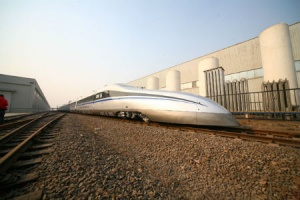CSR MU Base opened to fans for the first time

On February 10, “Fans to CSR” jointly organized by China South Locomotive & Rolling CSR and the railway website Hasea.com was launched. More than 40 domestic railway fans from various places of China arrived at the CSR MU Base in Qingdao to visit the Train Body Development Department and the Model Showroom at the Technology Center, the experimental plant of the National Engineering Laboratory, No. 7 and No. 8 Train Body Plants, Bogie Component Machining and Welding Assembly Plant, MU Assembly Plant, Subway Assembly Plant, and the higher speed test train.
Inside the Model Showroom, dozens of futuristic locomotive models showed the company’s direction of future R&D, which brought the fans a sci-fi feeling. Liang Jianying, Deputy Chief Engineer of CSR Sifang, introduced these models which not only fully reflected the Chinese cultural elements, but also had good aerodynamic performance to help the train to reduce aerodynamic drag and run faster, more stably and more securely. For this national confidentiality institution, the Model Showroom of the Technology Center was opened to the public for the first time.
Just after entering the laboratory, the fans found that a silver-gray CRH380A bogie was accepting the “bumping” on the testing table. The laboratory director told reporters that it was the 10-million cycle fatigue test for the bogie which was the core technology to guarantee that “eggs do not roll and water in a glass does not shake” on the high-speed rail.
Before leaving the base, fans noticed at the Engineering Laboratory that the critical speed and instantaneous speed of snake-like running MU reached 600 km/h. “We must ensure the security at the speed of 600 km/h or above and the good interactions of the entire operating system. It is what the safety margin we guarantee.” When developing the 380A, CSR Sifang has conducted 450 simulation calculations, 1050 ground tests, 2800 rail tests in Beijing-Tianjin, Wuhan-Guangzhou, Shanghai-Nanjing high-speed lines, covering a distance of more than 2 million kilometers, equivalent to 50 laps around the Earth. After fully validating the technical performance of CRH380A, they finally successfully developed it.
The plants visited in the morning were forbidden to take photos, but at the MU Assembly Plant, the fans got the “special permission”. They found the MU basically took shape and the veil of mystery was about to be opened. Without glass and floors, the high-speed MU was only waiting for the final decoration. ChinaRH2, a fan from Hasea.com, excitedly pointed at the MU which was to come into service and joked with reporters that maybe someday he might ride on the MU after it got off the assembly line and the probability was certainly high. Before leaving, fans watched workers methodically placing parts to regions reserved in advance. The standard pipeline operation made people comfortable.
ADVERTISEMENT
Of course, the brightest highlight of the tour was the higher-speed test train. Fans affectionately called it the “500-km MU” or “cit500”. Central Star, a senior fan, explained that the car’s design speed was 500 km/h, and it was expected to run faster to 600 km/h on proper lines.
The locomotive design of the higher-speed test train originates from the treasured sword.” said Liang Jianying. When a sword is drawn from the scabbard, the speed is very fast. Reporters on the scene found that the train only had six units, different from the usual MU, four of which contained a variety of computer equipment and only two were equipped with standard passenger compartments. And the shapes of first and tail cars were different. CSR Sifang technical personnel introduced that the train was a 6-car full-motion group for further study of China’s high-speed R&D tests and would not be put into commercial operation.
After the visit, CSR technical personnel conducted face-to-face communication with the fans, answered a series of questions the fans were interested in, and shared views about the “independent intellectual property rights of China’s high-speed rail” and “the future development direction of China’s high-speed rail” and other widespread issues.

